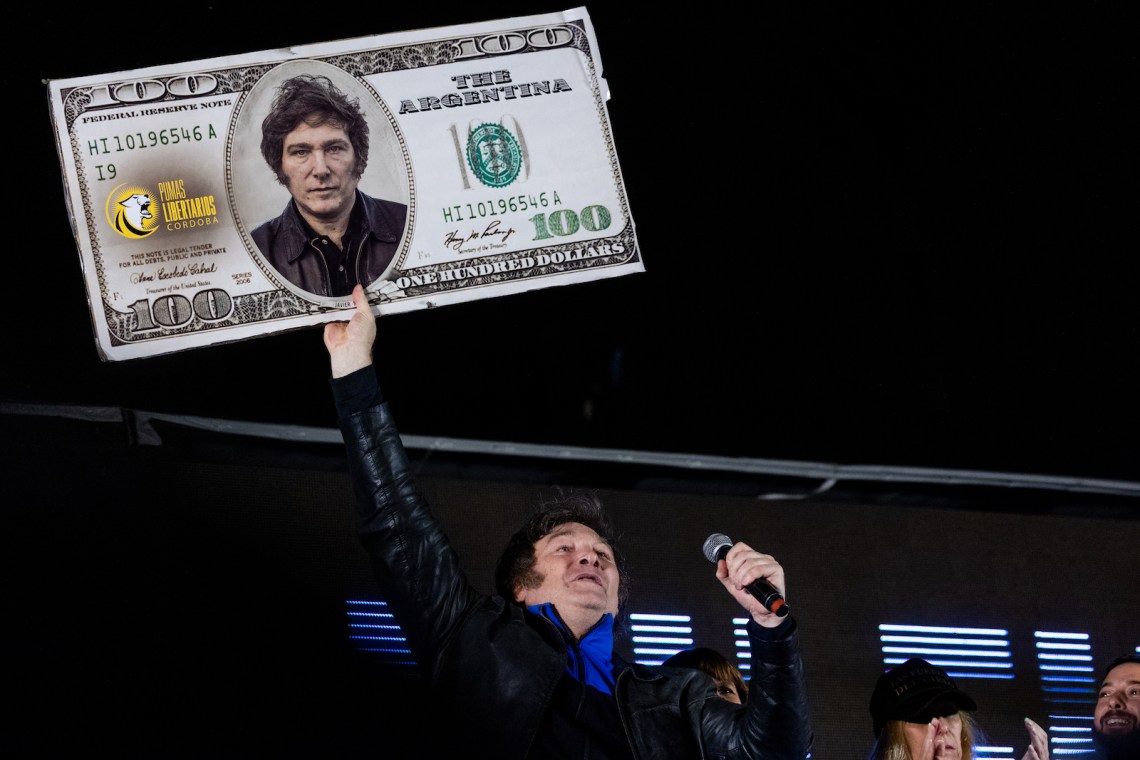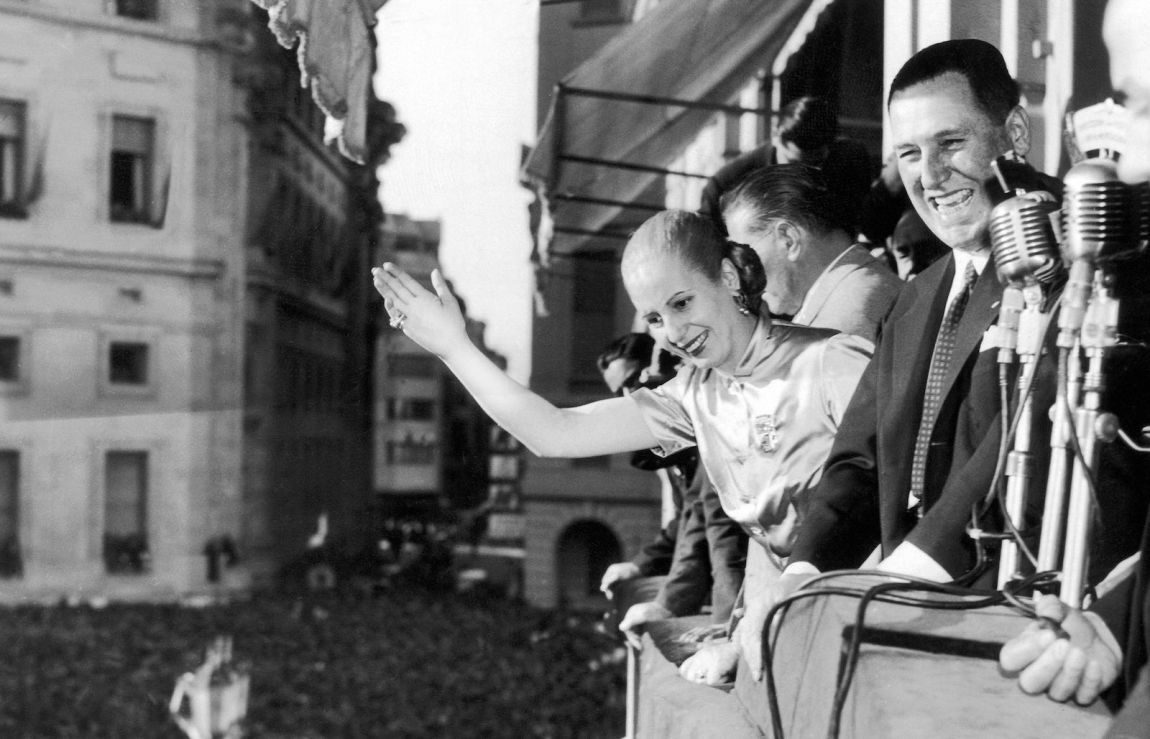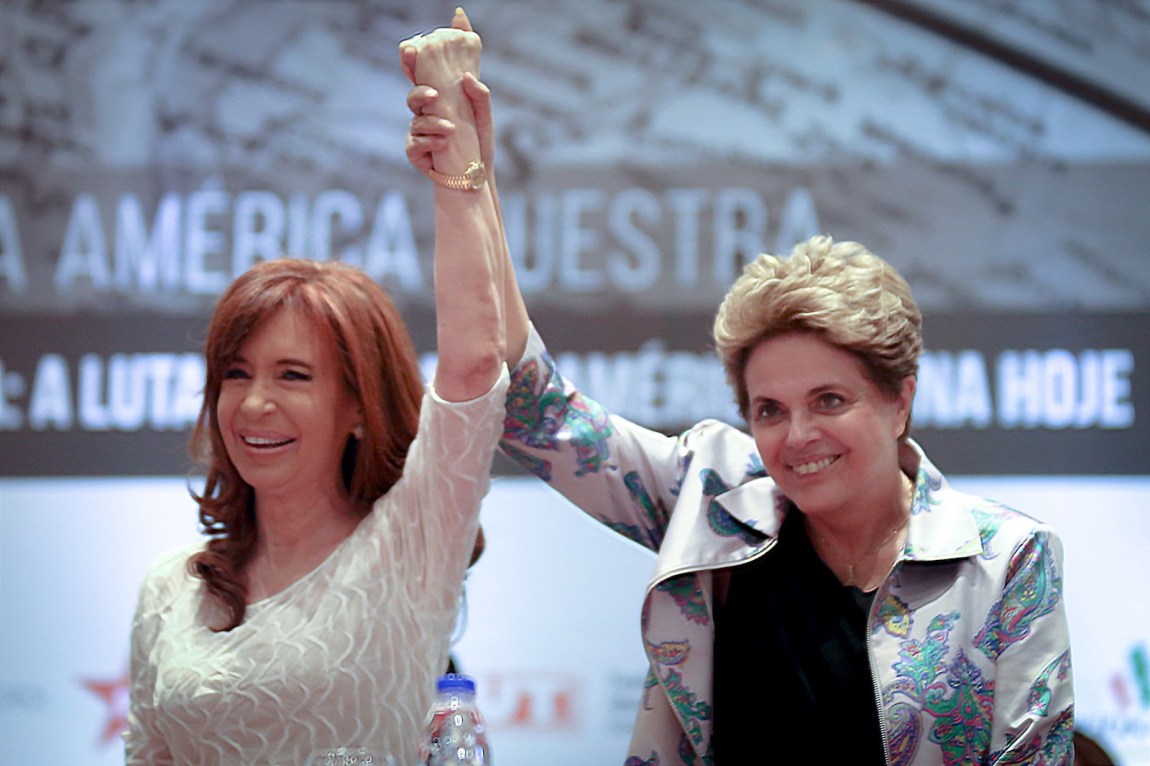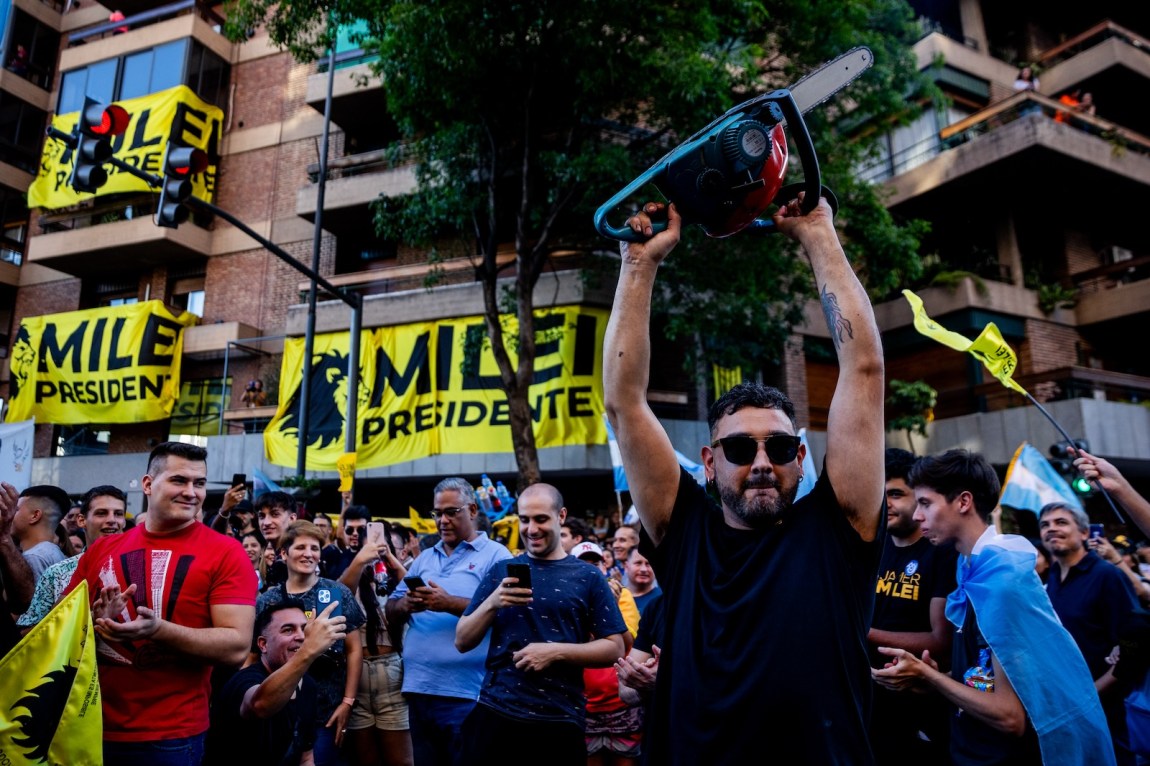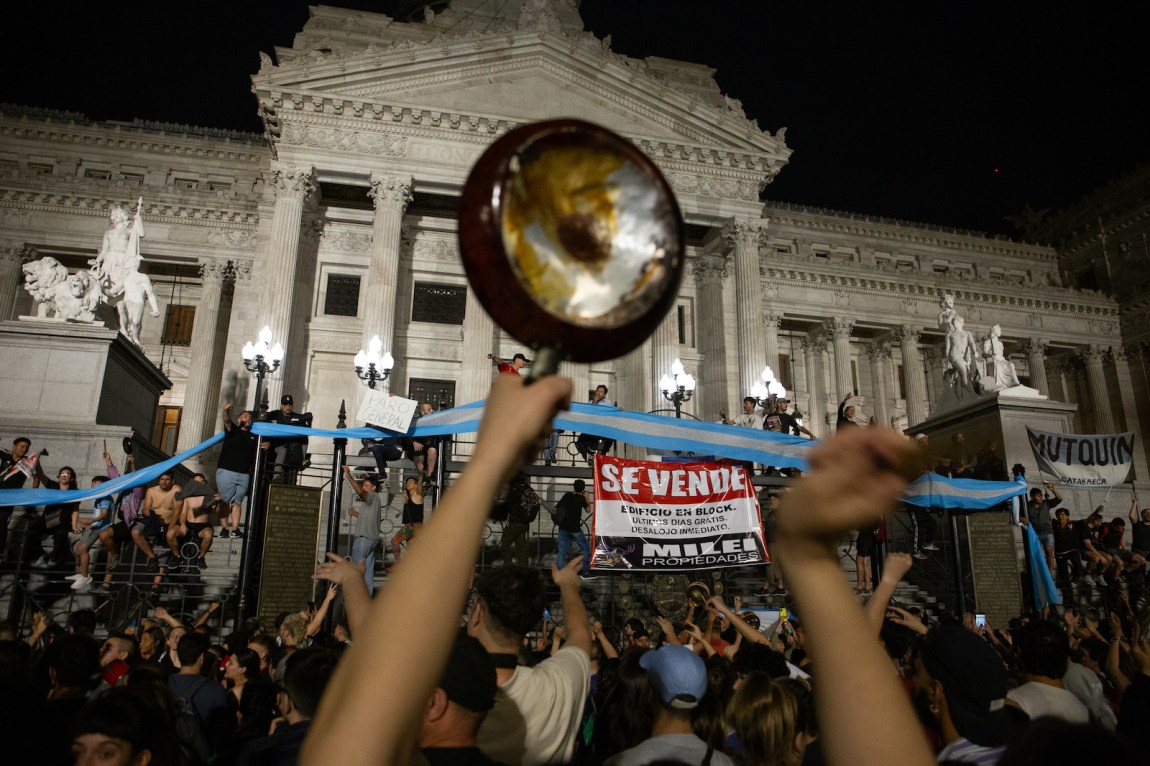In 1983, when Argentina held its first presidential election after seven years of military dictatorship, Raúl Alfonsín won with an optimistic slogan: “With democracy one eats, one is educated, one is cured.” He campaigned on moving past the junta’s reign of terror and restoring a welfare state. As the historian Jennifer Adair has argued, “the triple promise of political rights, physical safety and social well-being resonated in a country where many understood political terror and social deprivation to be bound up with one another.”1 Over the next four decades Argentine governments of various ideologies have been judged in the light of this basic political agreement.
Javier Milei’s victory in last November’s presidential elections could mark the end of this specific conception of democracy. Milei is a self-described “anarcho-capitalist,” which in his case means that he believes in extreme market deregulation and virulently opposes any state intervention in the name of the collective good. An economist by training, he proposes shutting down the Central Bank and replacing the Argentine peso with the US dollar. In televised debates he often mentions Friedrich Hayek and Ludwig von Mises. His main campaign promise was to get rid of “the caste,” “socialists,” and “populists”—derogatory markers used to tar anyone associated with the social and political establishment of the past four decades.
President Milei began his assault on the Argentine state immediately upon taking office last December. Right before Christmas, he signed a “megadecree,” or omnibus executive order, that deregulated significant parts of the economy. It reduced severance compensations and transferred workers from union-assigned health care to a voluntary system; lifted ceilings on rent, credit card interests, land tenure, and private health insurance plans; pushed the privatization of state-owned companies (“All government companies should close down,” Milei has explained); paved the way for unregulated international fishing, indiscriminate mining, and unsupervised tactical burning of forests. On December 29 he sent Congress a sweeping “ley ómnibus” with 664 articles. One of them would grant him emergency executive powers, allowing him to unilaterally rule on fiscal and pension matters for up to two years, without Congressional approval. In some three months Milei has also closed or weakened the ministries of education, labor, human rights, women, and the environment.
Milei’s libertarian agenda does not allow for civil liberties and social rights. He has denounced “the atrocious notion that when there’s a need there is a right, whose highest aberration is social justice.” He made his intentions clear from day one, when he introduced a bill requiring government authorization for any public meeting of more than three people. Ten days into his administration, loudspeakers at train stations in the working-class suburbs of Buenos Aires warned commuters not to join political demonstrations: those who block the roads, it announced, “don’t get paid” social benefits. The same day, before a rally of just a few hundred people, police boarded buses to search passengers with political signs. The “megadecree” outlawed protests that obstruct traffic.
Milei’s radical measures have already drawn fierce protests—from unions, feminists, and human rights groups, among others. All the same, he remains extremely popular. His ideas have struck a chord across Argentine society—among elites who oppose progressive economic policies as well as among workers and the unemployed, who have suffered from the shortcomings of these policies. Whether or not his project succeeds, the societal tensions it has brought to the fore will not disappear so easily.
*
Milei’s main opponent in the polls was Sergio Massa, who served as minister of economy under the outgoing president, Alberto Fernández. Massa and Fernández were allies of Kirchnerism, a progressive strain of Peronism that has dominated Argentine politics for much of this century, named for the late Néstor Kirchner, who served as president from 2003 to 2007, and his wife, Cristina Fernández de Kirchner, who was president for the next eight years and then vice president from 2019 to 2023. One way of understanding Milei’s rise is as a rejection of Kirchnerism, and to some extent of the Peronist legacy itself.
In 1945 unions and workers embraced Juan Perón as their leader, and in 1946 they led him to presidential victory. Over the following decade, Perón led a process of wealth redistribution, helped construct the welfare state, actively involved labor leaders in national politics, and expanded social and political rights, including by establishing women’s suffrage. The Peronist social revolution was also authoritarian: the government prosecuted opposition leaders, imposed censorship, and oversaw a massive cult of personality centered on Perón and his wife, Eva, who died in 1952. But it was the depth of social change that led the military to overthrow Perón in 1955, after which the party was banned and Argentinians were forbidden from mentioning his name—or Eva’s—in public.
Advertisement
When Peronism was allowed to participate in open elections eighteen years later, in 1973, Perón was reelected, only for his party to be toppled by another coup in 1976. Since the restoration of democracy in 1983, Peronism has won six of ten presidential elections. In this period it has been associated, paradoxically, both with the expansion of social welfare and with neoliberal reforms. The widening gap between those agendas is in part what set the stage for Milei.
Perhaps no president better represented the contradictions of Peronism than Carlos Menem. He came to power in 1989, when Alfonsín left office six months before his term ended. Inflation was at 3,079 percent, and over a dozen people had been killed in riots. That was the tragic end to Alfonsín’s twin promises of political freedom and material improvement. Menem blamed inflation on excess fiscal deficit, which he in turn attributed to bloated public companies and industrial protectionism. As a cure he pushed through a combination of privatization, government layoffs, spending cuts, and deregulation.
The bitter pill of austerity did not cure inflation. In 1991, as a last resort, Menem pegged the peso to the US dollar—the Argentine government would henceforth only print pesos that were backed by dollars in the Central Bank’s vault. The goal was to stabilize the currency, and inflation did abruptly fall to 17.6 percent in 1992, to 7.4 percent in 1993, and then 3.9 in 1994. But the government had effectively traded away its ability to shape fiscal policy. The only ways left to generate pesos were to drive up exports by lowering wages, to draw capital investment by privatizing more companies, and to take loans in global financial markets. In sum Menem’s policies lowered inflation and shot up unemployment, poverty, and external debt. Milei has cited them as the inspiration for his proposal to totally dollarize the economy: both approaches seek to establish economic order at all costs.
Menem’s policy was squarely in keeping with the Washington Consensus—a set of ten policy measures drawn up by the British economist John Williamson in 1989 and advocated by organizations like the World Bank and International Monetary Fund, with the strong backing of the US. This program recommended that Latin American governments, many of which were then mired in debt, open up their markets, set competitive exchange rates, and institute forms of “macroeconomic discipline” such as spending cuts. At the 1994 Summit of the Americas, President Bill Clinton described the Consensus as “a partnership for prosperity where freedom and trade and economic opportunity become the common property of the people of the Americas.”
It was accepted that jobs would be sacrificed in Argentina until the partnership took off. Under that rationale, in 1994 Menem introduced a Conditional Cash Transfer (CCT) program, which was intended to ease the structural transition until the emerging private sector created new forms of employment. Also in keeping with the Washington Consensus, CCT made welfare conditional on the recipient’s actions: they had to take training courses, sweep streets, maintain public buildings, and so forth.
Yet the new jobs never materialized. The agricultural sector grew as new technology and fertilizers improved productivity, but the need for field labor stayed roughly the same. To increase efficiency, newly privatized companies hired fewer workers than the public ones they replaced, then made further layoffs. Millions were thus forced into self-employment; they opened mom-and-pop shops and drove taxis. Marginal services of this kind, however, could hardly lead to meaningful economic growth. Unemployment went from 7.2 percent in 1989 to 14 percent a decade later, and jumped to 21.5 in May 2002—the highest rate on record. Poverty hovered between 15 and 30 percent throughout the period. As many suspected from the outset, CCT had to be made permanent.
Radical theories of economic liberalism were gradually normalized in those years, eventually becoming common sense in policy circles. I saw this firsthand when, in 1998, I paid a visit to the leader of a progressive coalition that was preparing to compete against the Peronists. He introduced me to an economist named Federico Sturzenegger, who would, he said, “help us develop long-term policies.” Sturzenegger told me that most reforms from the 1990s would have to be retained to lower the stubbornly high unemployment rate; fighting corruption would suffice to change the economic landscape.
In 2001 Sturzenegger joined the Alliance government, led by President Fernando de la Rúa from the Radical Civic Union. Having ousted Menem from power in 1999 on a progressive platform, the Alliance was unable to detach the peso from the dollar and deepened the recession. In December 2001, amid a banking panic, de la Rúa fled the Casa Rosada in a helicopter during riots in which thirty-nine people were killed. Sturzenegger resurfaced in 2015 as governor of the Central Bank during the center-right government of Mauricio Macri. Now he is part of Milei’s administration; he was the mastermind behind the executive orders and bills during the president’s early weeks.
Advertisement
*
Many of those who voted for Milei grew up in an economy that thrived between 2003 and 2010 under the Kirchners. They rejected most policies associated with Menem and instead followed a progressive agenda that benefitted the unemployed and people marginalized during the reforms of the 1990s. In this, they were part of the “pink tide” of progressive leaders in Latin America during this period, among them Brazil’s Luiz Inácio Lula da Silva, Bolivia’s Evo Morales, and Ecuador’s Rafael Correa.
The core of the Kirchners’ economic plan was, as E. B. White would say, to beat nature into submission. Gas, oil, soy, gold, silver, manganese, lithium—the global commodity boom led to an influx of capital. The economy grew an average of 8 percent per year. “Chinese growth rates!” exclaimed the Kirchners’ supporters, perhaps unaware of the full implications of the metaphor.
Through different forms of taxes, special levies, and subsidies, the Kirchner governments transferred revenue from extraction to the rest of the economy. In addition to significantly expanding social programs, they introduced energy and transportation subsidies. Air conditioners appeared in slums and working-class neighborhoods, to the horror of many in the middle and upper classes (who also benefited from cheaper prices). Factories were set up to make or assemble air conditioners as well as food products, textiles, and even cars. Formerly privatized companies were brought back under state control, including rail and oil. Some of Milei’s supporters among the poor would have got their first computer through a nationwide program launched by Cristina Kirchner in 2010, which delivered them for free to students on the condition that they finished high school. The computers were manufactured in Argentina.
The Kirchners gave more political representation to the unemployed and workers in the informal sector, much as Perón had engaged organized labor in the 1940s. Starting in 2003 the Movimiento de Trabajadores Desocupados (Movement of Unemployed Workers)—an organization with origins in street protests—and similar groups were charged with distributing government aid through systems like soup kitchens and cash funds. This also revealed a tacit acknowledgement that the Argentine economy had decisively moved away from formal employment.
There were other progressive gains. Domestic workers obtained social security; same-sex marriage was legalized; a vast naturalization program for immigrants was established; the voting age was reduced from eighteen to sixteen; and trials for human rights violations during the dictatorship gathered pace. Argentina also played a crucial part in forging a more independent regional bloc—the only one in the world that did not authorize black sites and black flights during the US war on terror. The bloc also rejected the US-sponsored free trade agreement during a hemisphere-wide conference in 2005 in Mar del Plata. At the conference, President George W. Bush was embarrassingly seated meters away from Kirchner, Lula, and Hugo Chávez, while Diego Maradona rallied thousands of protestors outside.
The historian Tulio Halperín Donghi has argued that Peronism was “three years that lasted for fifty.” His point was that the experience of social inclusion during Perón’s early years in power forged a lasting political identity among workers. Kirchnerismo might not have left as deep an imprint, but workers, the unemployed, and the poor coalesced around the policies of Néstor and Cristina, creating a new political subject. This helps explain why many people persisted in associating Kirchnerism with general well-being, despite everything that happened later. It also suggests how anti-Kirchnerism became a powerful vehicle for upper-class revenge. In the eyes of their opponents, the average Kirchnerista came to be typically imagined as an unemployed or informal worker who received government benefits in exchange of political subordination, with a taste for local trap music and a diet of guts and cheap cuts.
*
Kirchnerism was predicated on high commodity prices. It brought in vast amounts of capital but failed to offer the Argentine economy a path forward beyond extractivism. Energy subsidies had allowed private companies (many of them transnational groups with local partners) to get along by investing little in infrastructure, which in turn created economic bottlenecks. Industrial jobs had grown, but they still represented just 26 percent of the total workforce in 2015, similar to neighboring Brazil and Chile.
The model began to expose its flaws after 2010, as the commodity boom stalled and financial markets dried up. Foreign companies scaled down their activities or transferred them elsewhere; local ones suffered. Falling growth led the government to expand the CCT and other social programs, but rising prices still rendered aid insufficient, forcing recipients to make up for the deficit with supplemental work in the informal sector. This is what happens when a twenty-first-century neoliberal state—having lost much of its power due to downsizing and forced to depend on the whims of the private sector—nonetheless tries to implement 1960s-style developmentalist policies that are predicated on active government investment in domestic markets and industries.
Many of those who entered the job market after 2010 care little about labor rights because they never had them to begin with. In the 1970s seven of eight million economically active Argentine workers were in the formal sector; of those, two million were in the public sector. Today barely half of the 21 million active workers are in the formal sector. Soup kitchens, open-air markets, and gig work mark a disjointed landscape of labor. With unemployment at 9 percent and poverty at 40 percent, millions are working even as they fail to make ends meet.
Voters also became increasingly ambivalent about the benefits of the welfare state as its effectiveness dwindled. For most of the second half of the twentieth century, Argentina’s literacy rate was close to 95 percent, supported by a massive public education system. Today, for every hundred students who enter public primary school, only forty-six graduate passing the Pruebas Aprender—a standardized test in mathematics and Spanish. Just half make it to the end of high school, and a paltry sixteen pass the version of the test designed for that stage. Public hospitals were once the gems of the Argentine welfare state. As the middle and upper-middle classes absconded to the private system, however, the quality of care declined. Today half of lower-income patients have not visited a doctor in a year; those who do face waits two or three times longer than those in the private health care system. “Most of those funding public goods have abandoned them a long time ago,” the sociologists Javier Auyero and Sofia Servián have argued. “Those who use them feel them broken and shattered.”2
As Kirchnerism slowly came apart, opposition to social spending grew on the right and among elites, who made arguments based more on social resentment than economic rationality. In 2010 Ernesto Sanz, the leader of the opposition party, said that “the money from Universal Child Allowance”—the largest social plan at the time—“goes to drugs and gaming.” Six years later Enrique Pescarmona, leader of one of the biggest corporations in Argentina, told an audience of businessmen that teenagers got themselves pregnant to secure public funds.
Around this time a new term emerged in right-wing discourse. Choriplanero is a portmanteau that combines chori—a familiar diminutive of choripán, a popular sandwich handed out at political rallies—with planero, a neologism of its own denoting those who receives planes (welfare benefits). Choriplanero suggests that recipients of political handouts get planes and choripanes. The term, central to antipopulist rhetoric, hints at a supposed irrationality and weakness of poor people, as if those who support Peronism or cause social unrest are acting out of mindless hunger. It directs attention away from the structures that perpetuate inequality and toward the recipients of aid, whom it villainizes. On one side, people as different as delivery workers, permanent workers, and CEOs; on the other, choriplaneros.
In 2015 the Kirchners were finally voted out of power. Macri’s center-right coalition took office with the support of the heads of the “unicorn” companies (as startups with values of over $1 billion are known), major agrobusiness players, and leaders in the financial and energy sectors, many of them beneficiaries of Kirchnerism. Macri mishandled the economy—imposing additional austerity measures, taking out a $57 billion IMF loan—and was in turn defeated by Peronism under Alberto Fernández in 2019. During the pandemic Fernández’s government created the Emergency Family Income program, which gave cash aid to families in need. More than nine million people applied, in a country of 45 million people. This temporary plan was also made permanent. Yet it was unable to deal with the underlying economic causes that led to rising prices and poverty.
In 2022 the economic minister, Martín Guzmán, proposed an IMF-backed adjustment plan to bring inflation under control. Under pressure from Vice President Cristina Kirchner and afraid that the suggested cuts to public spending (including subsidies for energy and transportation) would hurt their electoral chances, Fernández sacked Guzmán that July. He was replaced by Sergio Massa, who was also declared the presidential candidate. It was hardly an inspiring choice. A power broker from Buenos Aires Province whose origins are in a right-wing party, Massa ran a campaign vowing to protect democracy while his own ministry oversaw a 160 percent inflation rate.
As if in a harbinger, that year a low-ranking member of a fringe right-wing organization, the Federal Revolution, put a gun to Cristina Kirchner’s head outside her apartment. He fired, but the gun malfunctioned. A few months earlier he had appeared on television selling cotton candy from a street cart, condemning choriplaneros, and praising his girlfriend, who “renounced her benefits and decided to make the same money here, but working instead of getting cash from the government.”
*
The political scientist Verónica Gago charted the rightward shift of Argentina’s lower-middle class and poor in her book Neoliberalism from Below (2014). Gago analyzes how, starting in the late 1990s, these groups came to see individual effort as the only way to fight precarious labor prospects and deteriorating standards of life. She takes as her case study La Salada, a twenty-acre open-air market on the outskirts of Buenos Aires, where counterfeit textiles made in illegal factories are sold. It’s a potent symbol of the kind of informal work toward which greater numbers of Argentines have gravitated. There, they forged a social identity that embraces individual entrepreneurship and opposes a reliance on government aid, even if many of them also receive some forms of benefits.
Milei’s genius was to channel their multiple resentments against state mismanagement of the economy. He emerged in public life in the 2010s as a guest in television debates over government spending. He was attractive to producers: eloquent, aggressive, with lower-middle class roots, and a gift for conveying economic ideas in simple language. His personal eccentricities turned heads: he has played in a Rolling Stones cover band and worked as a tantric sex coach, and he sports a Wolverine-like hairdo. From the first Milei displayed an unwavering faith in libertarianism. His “only hero” and “source of wisdom” in economic philosophy is Alberto Benegas Lynch, a member of the Mont Pelerin Society and a scholar at the Cato Institute. Lynch’s father had criticized the last military dictatorship for “giving in to the temptation of redistributive policies.” His son, meanwhile, is now a congressman in Milei’s party, La Libertad Avanza (LLA); he floated the proposal to close the Central Bank.
Politicians initially dismissed Milei as a charlatan. Yet he found a following on social media. TikTok and WhatsApp are to Milei what the radio was to FDR or to Getúlio Vargas in Brazil in the 1930s—a way to connect directly with voters. The difference is that while radio listeners were passive recipients of information, Milei’s followers actively participate in his project. As well as sharing his videos, they make their own, weaving narratives about their run-down neighborhoods, their struggles as Uber drivers and delivery workers, their clashes with local power brokers, their long wait times at public hospitals. Government spending, bureaucracy, and corruption are inevitably presented as the roots of individual and national decline.
The reporter Victoria De Masi has offered some of the best chronicles of the libertarian revolution that Milei has set in motion. Last December, in San Martín, a working-class suburb of Buenos Aires, she interviewed Yasmín Arabena Toledo, a thirty-year-old LLA activist who earns some $75 a month teaching remedial classes in public schools. Yasmín said she was waiting for “the caste to pay. . . . If a congressman earns 2 million pesos, he should get 25% of it. They should feel it.” Her other target was the beneficiaries of social programs:
They just increased the amount they get with the excuse that they can’t make it. But workers can’t make it either and we don’t get a raise. They take money from me and give it to them, the planeros.
Milei formed LLA in 2021. Even though the party had no meaningful organization, it still earned 5.5 percent of the vote in the midterm elections that year, with a peak of 17 percent in Buenos Aires. Milei’s media presence steadily grew over the next two years, thanks to relentless campaigning on the principles of his idol, the American economist Murray Rothbard. In his 1992 essay “Right-Wing Populism: A Strategy for the Paleo Movement,” Rothbard urged right-wing leaders to grab political center stage using extreme proposals and aggressive rhetoric. Milei took this lesson to heart. He advanced outrageous ideas like a free market for buying and selling human organs and lauded the “seasteading” movement, which urges “aquapreneurs” to colonize the oceans—an idea pushed by Patri Friedman, Milton’s grandson.
Last August, to the shock of most observers, Milei finished first in open presidential primaries, with 30 percent of the vote. Massa staged a recovery and overtook him in the first round of the presidential elections in October. But then Macri brokered a deal between Milei and the center-right third-place candidate, Patricia Bullrich, who endorsed LLA. This Faustian pact proved decisive. It brought Milei a wider conservative base, the support of crucial political brokers, and ten governors. When runoff elections were held in November, he won in twenty-one of twenty-four electoral districts.
Milei’s campaign was followed with interest by other leaders of the international far right. Jair Bolsonaro endorsed him; Hungary’s Viktor Orbán and Spain’s Santiago Abascal attended his inauguration; Tucker Carlson flew down to Buenos Aires for a flattering interview, the most-watched since he left Fox. These ties have grown stronger since Milei took office. On February 23 he flew to Maryland to participate in the Conservative Political Action Conference (CPAC), along with Donald Trump, Steve Bannon, Nigel Farage, and Nayib Bukele.
But Milei stands apart in important ways. In a comparative study of voters who backed Milei and Bolsonaro, the Brazilian lawyer Julia Almeida found that the former cared less about cultural issues like abortion and gun ownership and more about economic issues like unemployment benefits and labor rights, both of which they strongly opposed. Almeida also noted that Milei won among voters between sixteen and thirty-five, with a demolishing 78 percent between sixteen and twenty-four, as compared to contemporary far-right leaders in Brazil, the US, and Spain, who relied on older voters.
At the same time Milei has also found support among the very rich. He was backed by the young billionaire Marcos Galperín, founder of the e-commerce company Mercado Libre (“Free Market”), who in 2020 moved his residence to Uruguay, infuriated with Argentina’s overbearing taxes; by a main member of the Grobocopatel family, one of the largest wheat and soy producers in Latin America, which made a killing on transgenic soy in the early 1990s; by the Werthein and Rocca families, who owe their fortunes to finance, energy, and construction (a scion of the former is now the ambassador to the US, and executives of the latter head the state oil company). Then there are global players: one of Milei’s first executive orders allowed operators to offer satellite and cable television as well as low-orbit satellite internet. This was intended to open a new market to Starlink, owned by Elon Musk, an outspoken supporter. The company will likely set up shop in Argentina within weeks.
*
Even as he rails against the political caste, Milei has been careful to support the military. His vice president, Victoria Villarruel, is the granddaughter, daughter, and niece of members of the armed forces. Her uncle, the intelligence officer Ernesto Villarruel, worked at the clandestine detention center El Vesubio during the military dictatorship. Villarruel herself has set up the Center for Legal Studies on Terrorism and its Victims, which called for the release of many military figures imprisoned for torture, assassinations, and kidnappings. It’s an intervention that effectively redefines human rights. Villarruel presents “urban crime, state negligence or corruption, and traffic accidents” as human rights violations on par with the military’s crimes, Verónica Torras, executive director of the human rights organization Memoria Abierta, told me. “At the same time…[the government] moves towards an increasing criminalization of social and economic rights.”
In a strange way Villarruel has come to frame the victims rather than perpetrators of the junta as members of la casta. She has accused the Mothers and Grandmothers of Plaza de Mayo—two leading human rights groups that seek reparations for the victims and sentences for the perpetrators of the last military dictatorship—of complicity with Kirchnerismo. On February 26 the government announced that it was canceling the program about their activities that the Mothers of Plaza de Mayo have run on national public television for decades. That these organizations were closely associated with the Kirchnerista governments and actively supported their policies beyond human rights, and that some of their prominent members attended political rallies with Néstor and Cristina, has made it easier for many to accept the indictment.
Villarruel’s hostility toward human rights activists points to a central aspect of Milei’s ideology of “anarcho-capitalism.” He has always insisted on the need for order: in the streets, in public spending, in respect for the military and security forces. His vision combines the total economic freedom of a tax haven like the Cayman Islands with the total political subordination of Guantánamo. These views are in keeping with the “radical form of capitalism” that Quinn Slobodian describes in Crack-Up Capitalism (2023), his study of free ports, tax havens, and special economic zones such as Singapore, Dubai, and Shenzhen. Slobodian warns that the spread of the libertarian dream of free economic zones portends not “the union of capitalism and democracy but their increasing divergence.”
Milei’s libertarian adventure might still go off the rails. On January 24, in response to a call from unions for a national strike, thousands took to the streets to protest his austerity proposals. On February 6 Congress voted down his request for special powers; courts are deliberating whether to scrap parts of his “megadecree.” The economic problems that Milei decried during the campaign are now for him to solve, and his base may sour if they deepen. He has flirted with the edge of the cliff of hyperinflation from day one: Late in 2023 the Central Bank devaluated the Argentine peso by 50 percent, raising prices even higher.
Milei has moved forward with massive spending cuts, and the adjustment has had an immediate impact; within two months, salaries lost 21 percent of their purchasing power. If cuts persist, inflation may lower as the economy stalls. A worsening situation might help justify total dollarization or further rollbacks of civil liberties. As his treasury attorney, Rodolfo Barra—a former member of the Menem administration who was photographed giving the Nazi salute in his youth—said, “If there is an economic crisis, there is no valid Constitution.”
In January inflation rose to over 20 percent. But rising costs alone will not decide Milei’s fate. In the absence of political alternatives, his supporters might stick with him no matter how high prices get. In The Economic Man (1939), Peter Drucker describes a scene in the early 1930s in which a crowd gathers in a street in Germany and cheers Nazi officials. “We don’t want lower bread prices,” they declare. “We don’t want higher bread prices, we don’t want unchanged bread prices—we want National Socialist bread prices.” In January 2024 the price of bread in Argentina rose at a rate higher than average inflation.


